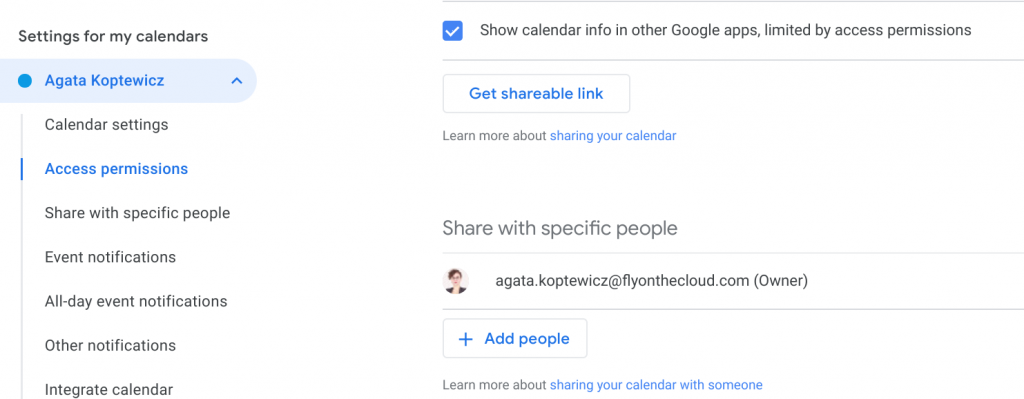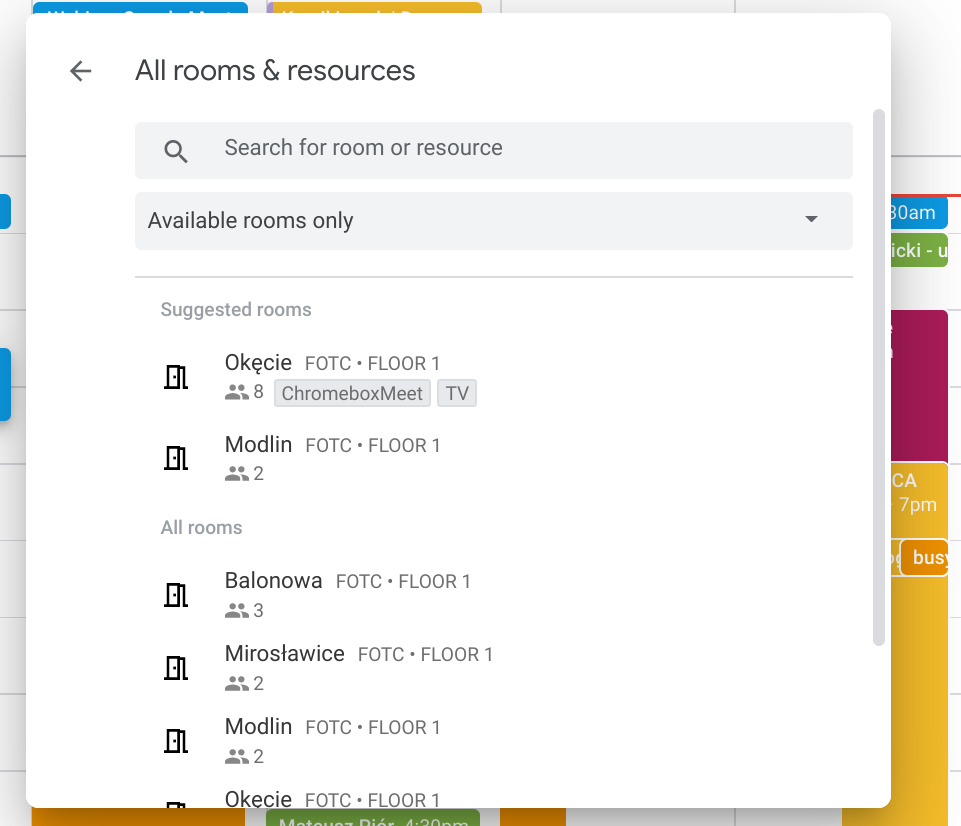Table of contents
- Advantages of using Google Calendar
- 1. Sharing your calendar with others
- 2. Create shared calendars for projects
- 3. Adding locations to events
- 4. Goals and resolutions
- 5. Adding an event from Gmail
- 6. Reminders
- 7. Creating a task list for a specific day
- 8. Marking holidays and days off
- 9. Time zones
- 10. Exporting the calendar to PDF
- 11. Remove weekends from Google Calendar
- 12. Google Meet and attachments in the event invitation
- 13. Booking resources
An increasing number of people are using Google Calendar for organizing their private and business schedules. However, not all of them are fully aware of its potential. This application allows for better organization of teamwork. The more you know about it, the easier it will be to stay on top of all your work and appointments. Let’s learn more about Google Calendar.
Advantages of using Google Calendar
Google Calendar is an app available in every Google Workspace edition and in the free version of Gmail for private users. It makes it much easier to manage individual and group schedules. The application is available for both desktop and mobile devices, so you can always have it at hand. This, in turn, eliminates the need to carry a paper organizer or use other apps – everything you write down is synchronized in real time on all your devices.
The biggest advantage of Google Calendar is its wide functionality. In this post, we present 13 basic tricks that will help you make the most of the application.
13 Google Calendar features you need to know
1. Sharing your calendar with others
Aligning schedules with several colleagues or friends can be a challenge. In Google Calendar, users get suggestions for meeting times that will fit in to the calendars of whomever is invited.
To share your calendar with another person, log in to Google Calendar and find the three dots button (it will appear when you hover over the name of the calendar). From the drop-down list, select ‘Settings and sharing’ and then click ‘Add people’. In addition, you can specify which rights will be given to the users to whom your schedule will be made available (they either gain access only to your availability details, or can edit all your entries).
In Google Workspace, the calendar is automatically shared with the entire organization.

2. Create shared calendars for projects
Google Workspace allows you to share additional calendars with other users. This makes is easier to create a work schedule for the entire company, one department, or a single project group. Such a shared schedule can be used to mark and plan holidays or meetings, as well as enter important deadlines for the project.
To create a calendar, open the Google Calendar application, click the plus next to ‘Other calendars’ and then select ‘Create new calendar’. The next step is to complete the data and make it available to all colleagues in the organization by clicking ‘Create calendar’.
3. Adding locations to events
Another advantage of Google Calendar is the ability to add event or meeting locations. Just use the “Add location” function when creating an event. This option, thanks to synchronization with Google Maps, makes it easier to indicate the exact address of the event. People using Google Calendar on their phones will be able to quickly check driving directions to the meeting place. Just tap or click the location and route on Google Maps will be calibrated automatically.
4. Goals and resolutions
The goals feature is available only in the mobile version of Google Calendar. Open the app and tap ‘+’ icon in the bottom right corner. Select ‘Goal’ from the list. The next step is to choose the type of activity, as well as the frequency of operation, the optimal time of the activity and the desired duration. Additionally, some activities can be combined with compatible applications, like Google Fit.
Google Calendar will also remind you whenever it’s time to complete a task. Users can mark the performance of the task and track own progress in achieving goals. The application notifies users in advance about approaching deadlines. This prevents the situation when following through on a resolution is impossible due to other overlapping activities.
5. Adding an event from Gmail
Google Calendar is compatible with Gmail. Received messages can be easily converted into appointments. To do this, go to the mailbox and open a message. Find the three dots icon in the upper right corner, click it, and then select ‘Create event’ from the list. The Google Calendar panel will automatically appear. The subject of the message will show as the subject of the meeting, and the content of the email will be included in details. All recipients of the email will be automatically invited.

See also:
- How to introduce and maintain Inbox Zero in Gmail?
- Gmail for business – everything you need to know before implementing it
6. Reminders
Google Calendar notifications can be displayed on your computer, mobile device, or received in the form of an email directly to your mailbox.
To enable browser notifications, log in to your Google Calendar. Next, find the gear icon and select ‘Settings’. In the left section, look for ‘General’ -> ‘Event settings’. In the ‘Notifications’ drop-down field, select the type of notifications you want to receive.
For mobile devices, log in to the Google Calendar application, enter the settings section and find ‘Events’. From there, the user can add, change or delete a notification.
7. Creating a task list for a specific day
Another advantage of Google Calendar is the ability to create a list of tasks to plan your activities. Google has created a ‘Tasks’ as a separate application. It is available from your Gmail, Calendar, and Google Keep mailbox. This tool allows creating and managing tasks for the day, and ticking the completed ones. You can view your to-do list directly in Google Calendar. Just select the ‘Tasks’ option on the left side of the calendar in the ‘My calendars’ section. It will be automatically added to the schedule.
8. Marking holidays and days off
In an international team, the possibility of marking holidays and days off may prove to be a very valuable functionality. Google Calendar allows you to import holidays from around the world.
To do this, go to ‘Settings’ and then, in the ‘Add calendar’, find ‘Browse calendars’. From there, you can tick the types of religious and sports events you want included in the schedule.
9. Time zones
In the case of foreign contractors, it is also useful to consider time zones. To make this possible, go to Settings> Time Zone -> Display Additional Time Zone. In the ‘Additional time zone’ window, select the time zone of interest to you, which will be displayed as a hint in the daily preview.
10. Exporting the calendar to PDF
The option of exporting the schedule to PDF may also come in handy. Select the gear icon and click ‘Print’. A new window will be displayed, in which you must specify, among others, the date range, font type and orientation. Here you can export a PDF file or print it to have a physical copy of your schedule.
11. Remove weekends from Google Calendar
Google Calendar allows you to hide weekends from the view, making the schedule more transparent. Go to the ‘Settings’ menu, find the section ‘View options’ and uncheck ‘Show weekends’.
12. Google Meet and attachments in the event invitation
In the ‘More options’ section of the events you create, you can also decide whether Google Calendar should automatically generate a link to the Google Meet meeting. In ‘Event details’ find ‘Add conferencing’ and select “Google Meet”.
13. Booking resources
In addition to scheduling events in Google Calendar, users can also book resources, like meeting rooms. Other examples can include projectors, company cars, guest offices, recreational areas and office equipment, as well as other items and places specific to your industry.
To define and manage resources in the Google Admin, you must have an account with administrator role. Reserving resources is available to all users in the organization.

